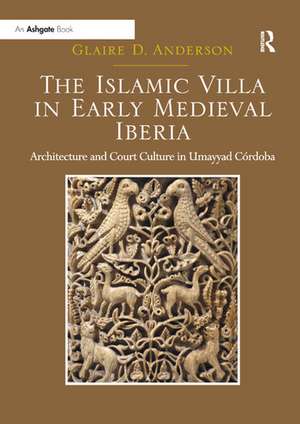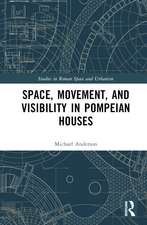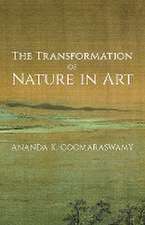The Islamic Villa in Early Medieval Iberia: Architecture and Court Culture in Umayyad Córdoba
Autor GlaireD. Andersonen Limba Engleză Paperback – 8 mar 2018
Preț: 325.34 lei
Preț vechi: 379.30 lei
-14% Nou
Puncte Express: 488
Preț estimativ în valută:
62.25€ • 64.100$ • 51.52£
62.25€ • 64.100$ • 51.52£
Carte tipărită la comandă
Livrare economică 04-18 aprilie
Preluare comenzi: 021 569.72.76
Specificații
ISBN-13: 9781138563223
ISBN-10: 1138563226
Pagini: 256
Dimensiuni: 174 x 246 x 21 mm
Greutate: 0.45 kg
Ediția:1
Editura: Taylor & Francis
Colecția Routledge
Locul publicării:Oxford, United Kingdom
ISBN-10: 1138563226
Pagini: 256
Dimensiuni: 174 x 246 x 21 mm
Greutate: 0.45 kg
Ediția:1
Editura: Taylor & Francis
Colecția Routledge
Locul publicării:Oxford, United Kingdom
Cuprins
Contents: Introduction; Social dimensions of patronage; Architecture and ornament; Gardens; The landscape of sovereignty; Epilogue; Appendix; Timelines; Bibliography; Index.
Notă biografică
Glaire D. Anderson is Associate Professor of Art History at the University of North Carolina at Chapel Hill, USA.
Recenzii
Prize: Winner of the Eleanor Tufts Award 2015, American Society for Hispanic Art Historical Studies
'This publication met and surpassed the stipulated award criteria of originality of conception, thoroughness of research, rigor of argument, brilliance of insight, significance of findings, and clarity of expression. Although the book will engage and satisfy specialists in Islamic art and architecture, Anderson‘s clear prose makes it accessible and valuable to anyone with an interest in a host of related fields.' The 2015 Eleanor Tufts Book Award Committee
'...an innovative study and an enjoyable read, conjuring a world of palaces and gardens, but providing at the same time a rigorous and serious study of the villa‘s function and meaning at the Umayyad court at an important moment of the dynasty‘s establishment and legitimation.' Mariam Rosser-Owen, Victoria and Albert Museum, UK
'Anderson‘s meticulous study illustrates the ways in which the country residences (munya) located in the region of C�ba formed an integral part of the political, cultural and economic life of the Umayyad dynasty. She demonstrates how ideas of sovereignty were intimately linked to the cultivation of the land, and provides important parallels between the munya and the Umayyad country residences of eighth-century Syria. This book makes a major contribution to our understanding of the culture of the villa in the Medieval Mediterranean.' Marcus Milwright, University of Victoria
'The Islamic Villa in Early Medieval Iberia provides a detailed and pleasant addition to literature on the Iberian peninsula, while expanding villa studies to encompass "nonWestern" examples. It will benefit those interested in this type of architecture as well as in the life and material culture of the Muslim elite of al-Andalus. Architects, historians, and art historians, as well as scholars and students of medieval culture, will undoubtedly enjoy Anderson's book.' Tradi
'This publication met and surpassed the stipulated award criteria of originality of conception, thoroughness of research, rigor of argument, brilliance of insight, significance of findings, and clarity of expression. Although the book will engage and satisfy specialists in Islamic art and architecture, Anderson‘s clear prose makes it accessible and valuable to anyone with an interest in a host of related fields.' The 2015 Eleanor Tufts Book Award Committee
'...an innovative study and an enjoyable read, conjuring a world of palaces and gardens, but providing at the same time a rigorous and serious study of the villa‘s function and meaning at the Umayyad court at an important moment of the dynasty‘s establishment and legitimation.' Mariam Rosser-Owen, Victoria and Albert Museum, UK
'Anderson‘s meticulous study illustrates the ways in which the country residences (munya) located in the region of C�ba formed an integral part of the political, cultural and economic life of the Umayyad dynasty. She demonstrates how ideas of sovereignty were intimately linked to the cultivation of the land, and provides important parallels between the munya and the Umayyad country residences of eighth-century Syria. This book makes a major contribution to our understanding of the culture of the villa in the Medieval Mediterranean.' Marcus Milwright, University of Victoria
'The Islamic Villa in Early Medieval Iberia provides a detailed and pleasant addition to literature on the Iberian peninsula, while expanding villa studies to encompass "nonWestern" examples. It will benefit those interested in this type of architecture as well as in the life and material culture of the Muslim elite of al-Andalus. Architects, historians, and art historians, as well as scholars and students of medieval culture, will undoubtedly enjoy Anderson's book.' Tradi
Descriere
Exploring the aristocratic villas and court culture of Córdoba during its 'golden age' under the reign of the Umayyad dynasty (r. 756-1031 AD), this study illuminates a key facet of the secular architecture of the court and its relationship to the well-known Umayyad luxury arts. Based on textual and archaeological evidence, it offers a detailed analysis of the estates' architecture and gardens within a synthetic socio-historical framework.













